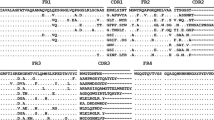Summary
A highly sensitive enzyme-linked immunosorbent assay (ELISA) for determination of ricin in serum is presented. Using this method it was found that IV-injected ricin disappeared from the plasma of mice and cancer patients according to first-order kinetics.
DBA mice were found to be more sensitive to ricin than C3H and B6D2 mice. When mice of the different strains were given the same dose of ricin, the concentrations found in liver, spleen, and kidneys were highest in the most sensitive mice. Ricin disappeared most rapidly from serum of the mice with the highest sensitivity. The inverse correlation between the rate of disappearance of ricin from serum and the tissue concentrations reached may be due to the fact that ricin is rapidly and firmly bound to cell surface receptors.
Whole-body autoradiography after IV injection of 125I-labeled ricin showed the highest amount of radioactivity in liver, spleen, and adrenal cortex. Considerable amounts of radioactivity were also present in bone marrow, showing that the lack of myelosuppressive activity of ricin previously found in mice and dogs cannot be accounted for by the failure of ricin to reach the bone marrow.
Part of the ricin in the tissues was present in the form of free chains, the highest fraction being present in the liver.
In this tissue both the free A-chains and those present in whole ricin were found to be modified. However, the modified A-chains had retained their full capacity to inhibit protein synthesis in vitro.
In cancer patients, toxicity appeared at about the same initial serum levels as in the mice, supporting the view that mouse data have a good predictive value for man. At each dose level the individual variations were modest, a finding that is important for eventual clinical use of this potent drug.
Similar content being viewed by others
References
Engvall E, Perlmann P (1972) Enzyme-linked immunosorbent assay, ELISA. III. Quantitation of specific antibodies by enzyme-labelled anti-immunoglobulin in antigen-coated tubes. J Immunol 109:129–135
Fodstad Ø, Pihl A (1978) Effect of ricin and abrin on survival of L1210 leukemic mice and on leukemic and normal bone marrow cells. Int J Cancer 22:558–563
Fodstad Ø, Pihl A (1980) Synergistic effect of adriamycin and ricin on L1210 leukemic cells in mice. Cancer Res 40:3735–3739
Fodstad Ø, Pihl A (1982) Synergistic effect of ricin in combination with daunorubicin, cis-dichlorodiammineplatinum (II) and vincristine in systemic L1210 leukemia. Cancer Res 42:2152–2158
Fodstad Ø, Olsnes S, Pihl A (1976) Toxicity, distribution and climination of the cancerostatic lectins abrin and ricin after parenteral injections into mice. Br J Cancer 34:418–425
Fodstad Ø, Olsnes S, Pihl A (1977) Inhibitory effect of abrin and ricin on the growth of transplantable murine tumors and of abrin on human cancers in nude mice. Cancer Res 37:4559–4567
Fodstad Ø, Johannessen JV, Schjerven L, Pihl A (1979) Toxicity of abrin and ricin in mice and dogs. J Toxicol Environ Health 5:1073–1084
Fodstad Ø, Aass N, Pihl (1980a) Response to chemotherapy of human malignant melanoma xenografts in athymic nude mice. Int J Cancer 25:453–458
Fodstad Ø, Aass N, Pihl A (1980b) An inverse relationship between the growth rate of human melanoma xenografts and their response to some cytostatic drugs. Br J Cancer 41:829–831
Fodstad Ø, Kvalheim G, Godal A, Lotsberg J, Aamdal S, Høst H, Pihl A (1984) A phase-I study of ricin, a toxic protein with anti-tumor properties. Cancer Res 44:862–865
Fraker PJ, Speck JC (1978) Protein and cell membrane iodinations with a sparingly soluble chloramide, 1,3,4,6-tetrachloro-3a, 6a-diphenylglycoluril. Biochem Biophys Res Commun 80:849–857
Godal A, Olsnes S, Pihl A (1981) Radioimmunoassays of abrin and ricin in blood. J Toxicol Environ Health 8:409–417
Godal A, Fodstad Ø, Pihl A (1983) Antibody formation against the cytotoxic proteins abrin and ricin in humans and mice. Int J Cancer 32:515–521
Kato K, Fukui H, Hamaguchi Y, Ischikawa E (1976) Enzyme-linked immunoassay: Conjugation of the Fab' fragment of rabbit 1gG with d-galactosidase from E. coli and its use for immunoassay. J Immunol 116:1554–1560
Laemmli UK (1970) Cleavage of structural proteins during the assembly of the head of bacterophage T4. Nature 227:680–685
Lin J-Y, Tserng K-Y, Chen C-C, Lin L-T, Tung T-C (1970) Abrin and ricin: New anti-tumor substances. Nature 227:292–293
Nisonoff A, Rivers MM (1961) Recombination of a mixture of univalent antibody fragments of different specificity. Arch Biochem Biophys 93:460–462
O'Keefe E, Bennett V (1980) Use of immunoglobulin-loaded protein A-bearing staphylococci as a primary solid phase immunoadsorbent in radioimmunoassay. J Biol Chem 255:561–568
Olsnes S (1978) Ricin and ricinus agglutinin, toxic lectins from castor bean. Methods Enzymol 50:330–335
Olsnes S, Pihl A (1973) Different biological properties of the two consituent peptide chains of ricin, a toxic protein inhibiting protein synthesis. Biochemistry 12:3121–3126
Olsnes S, Pihl A (1982a) Toxic lectins and related proteins. In: van Heyningen S, Cohen P (eds) The molecular actions of toxins and viruses. Elsevier/North Holland, Amsterdam, pp 51–105
Olsnes S, Pihl A (1982b) Chimeric toxins. Pharmacol Ther 15:355–381
Pihl A, Fodstad Ø, Olsnes S (1979) Anti-cancer properties of the toxic lectins abrin and ricin. In: Peeters H (ed), Proceedings of the XVII Annual Colloquium on Protides of the Biological Fluids. Pergamon, Oxford, pp 631–636
Sandvig K, Olsnes S, Pihl A (1976) Kinetics of binding of the toxic lectins abrin and ricin to surface receptors of human cells. J Biol Chem 251:3977–3984
Thorpe PE, Ross WCJ (1982) The preparation and cytotoxic properties of antibody-toxin conjugates. Immunol Rev 62:185–216
Ullberg S (1954) Studies on the distribution and fate of 35S-labelled benzylpenicillin in the body. Acta Radiol [Suppl] 118:1–110
Vitetta ES, Krolick KA, Uhr JW (1982) Neoplastic B cells as targets for antibody-ricin A-chain immunotoxins. Immunol Rev 62:159–183
Author information
Authors and Affiliations
Rights and permissions
About this article
Cite this article
Godal, A., Fodstad, Ø., Ingebrigtsen, K. et al. Pharmacological studies of ricin in mice and humans. Cancer Chemother. Pharmacol. 13, 157–163 (1984). https://doi.org/10.1007/BF00269021
Received:
Accepted:
Issue Date:
DOI: https://doi.org/10.1007/BF00269021




